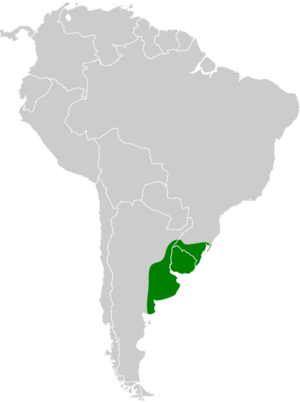Sulphur-bearded reedhaunter facts for kids
Quick facts for kids Sulphur-bearded reedhaunter |
|
|---|---|
 |
|
| Conservation status | |
| Scientific classification | |
| Genus: |
Limnoctites
|
| Species: |
sulphuriferus
|
 |
|
| Synonyms | |
|
Cranioleuca sulphurifera |
|
The sulphur-bearded reedhaunter (Limnoctites sulphuriferus) is a small bird found in Argentina, Brazil, and Uruguay. It gets its name from the bright yellow feathers on its throat, which can look like a yellow beard! This bird is part of the Furnariidae family, also known as the ovenbirds.
Contents
About Its Name
Birds are grouped by scientists to understand how they are related. This is called taxonomy. For a long time, the sulphur-bearded reedhaunter was placed in a group called Cranioleuca.
However, after a study in 2011, scientists decided it fit better in a different group, Limnoctites. Here, it joined a bird called the straight-billed reedhaunter. Most big bird organizations, like the American Ornithological Society, now use this new grouping.
What It Looks Like
The sulphur-bearded reedhaunter is a small bird, about 15 to 16 cm (6 inches) long. It weighs around 12 to 14 grams, which is about as much as a few paper clips!
Both male and female birds look alike. They have a light, streaky face with a pale stripe above their eye. Their back and head are olive-brown. Their tail feathers are pointed, with the middle ones being longer and brownish.
Their wings have rusty-red (rufous) and dark brown feathers. The most special part is their chin and throat, which are bright yellow. Their chest is whitish with thin gray streaks, and their belly is whitish too. Their legs are a greenish-gray color. Young birds look a bit different, with darker upper parts and no yellow on their chin.
Where It Lives
This bird lives in parts of southern Brazil, all of Uruguay, and eastern Argentina. It likes wet places called marshes. These marshes have tall grasses or reeds. Sometimes, it also lives in bushy areas next to the marshes.
You can find these birds from sea level up to about 300 meters (980 feet) high.
Bird Behavior
Movement
The sulphur-bearded reedhaunter stays in the same area all year round. It does not migrate to other places for different seasons.
What It Eats
Scientists believe this bird mostly eats arthropods, which include insects and spiders. It usually looks for food alone or with one other bird. We don't know much more about what else it eats or how it finds its meals.
Life Cycle and Breeding
Sulphur-bearded reedhaunters lay eggs during the spring and summer in the Southern Hemisphere. They are thought to stay with one partner.
Their nest is shaped like an oval ball. It's made from pieces of reeds and other plant fibers, and it's lined with soft grasses and feathers. They attach their nests to reed stems, usually just above the water. Sometimes, they build them above mud or dry ground.
A female bird usually lays three eggs, but sometimes it can be two or four. We don't know how long the eggs take to hatch or when the young birds leave the nest.
Bird Song
The song of the sulphur-bearded reedhaunter is a rising trill that lasts a few seconds. It sounds like "d-d-d-r-r-i-i-, dirip, dirip, dirip, drip-drip-dreeuw-dreeuw". Sometimes, a pair of birds will sing together, which is called a duet. You can listen to their songs online.
Conservation Status
The IUCN (International Union for Conservation of Nature) has listed the sulphur-bearded reedhaunter as a species of "Least Concern." This means it's not currently in danger of disappearing.
It lives across a large area, but its total population size is unknown. Scientists believe its numbers might be slowly decreasing. There are no big threats identified right now. The bird is common in some places but rare in the southern parts of its range.
Because it lives only in wetlands, it can be affected by problems that harm these special habitats. It is protected in two areas in Argentina.


